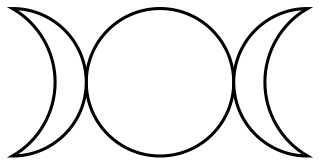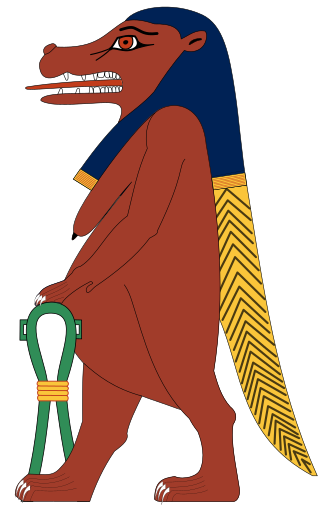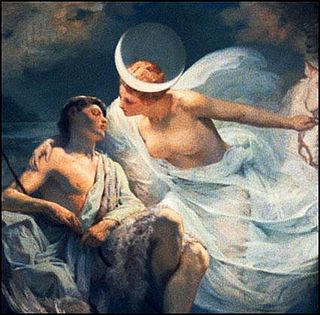Related Research Articles

In ancient Greek religion and mythology, Artemis is the goddess of the hunt, the wilderness, wild animals, nature, vegetation, childbirth, care of children, and chastity. In later times, she was identified with Selene, the personification of the Moon. She was often said to roam the forests and mountains, attended by her entourage of nymphs. The goddess Diana is her Roman equivalent.

Diana is a goddess in Roman and Hellenistic religion, primarily considered a patroness of the countryside and nature, hunters, wildlife, childbirth, crossroads, the night, and the Moon. She is equated with the Greek goddess Artemis, and absorbed much of Artemis' mythology early in Roman history, including a birth on the island of Delos to parents Jupiter and Latona, and a twin brother, Apollo, though she had an independent origin in Italy.

A goddess is a female deity. In many known cultures, goddesses are often linked with literal or metaphorical pregnancy or imagined feminine roles associated with how women and girls are perceived or expected to behave. This includes themes of spinning, weaving, beauty, love, sexuality, motherhood, domesticity, creativity, and fertility. Many major goddesses are also associated with magic, war, strategy, hunting, farming, wisdom, fate, earth, sky, power, laws, justice, and more. Some themes, such as discord or disease, which are considered negative within their cultural contexts also are found associated with some goddesses. There are as many differently described and understood goddesses as there are male, shapeshifting, or neuter gods.
Hecate is a goddess in ancient Greek religion and mythology, most often shown holding a pair of torches, a key, or snakes, or accompanied by dogs, and in later periods depicted as three-formed or triple-bodied. She is variously associated with crossroads, night, light, magic, protection from witchcraft, drugs, and the Moon. Her earliest appearance in literature was in Hesiod's Theogony in the 8th century BCE as a goddess of great honour with domains in sky, earth, and sea. She had popular followings amongst the witches of Thessaly, and an important sanctuary among the Carians of Asia Minor in Lagina. Her oldest known representation was found in Selinunte, in Sicily.

In Greek mythology, Galanthis or Galinthias was the woman who interfered with Hera's plan to hinder the birth of Heracles in favor of Eurystheus, and was changed into a weasel or cat as punishment for being so insolent as to deceive the goddesses of birth that were acting on Hera's behalf.

In Sabine and ancient Roman religion and myth, Luna is the divine embodiment of the Moon. She is often presented as the female complement of the Sun, Sol, conceived of as a god. Luna is also sometimes represented as an aspect of the Roman triple goddess, along with Diana and either Proserpina or Hecate. Luna is not always a distinct goddess, but sometimes rather an epithet that specializes a goddess, since both Diana and Juno are identified as moon goddesses.

Nut, also known by various other transcriptions, is the goddess of the sky, stars, cosmos, mothers, astronomy, and the universe in the ancient Egyptian religion. She was seen as a star-covered nude woman arching over the Earth, or as a cow. She was depicted wearing the water-pot sign (nw) that identifies her.

Asherah was a goddess in ancient Semitic religions. She also appears in Hittite writings as Ašerdu(s) or Ašertu(s), and as Athirat in Ugarit. Some scholars hold that Yahweh and Asherah were a consort pair in ancient Israel and Judah, while others disagree.

The Triple Goddess is a deity or deity archetype revered in many Neopagan religious and spiritual traditions. In common Neopagan usage, the Triple Goddess is viewed as a triunity of three distinct aspects or figures united in one being. These three figures are often described as the Maiden, the Mother, and the Crone, each of which symbolizes both a separate stage in the female life cycle and a phase of the Moon, and often rules one of the realms of heavens, earth, and underworld. In various forms of Wicca, her masculine consort is the Horned God.

The Floralia was a festival of ancient Roman religion in honor of the goddess Flora, held on 27 April during the Republican era, or 28 April in the Julian calendar. The festival included Ludi Florae, the "Games of Flora", which lasted for six days under the empire.

Juno was an ancient Roman goddess, the protector and special counsellor of the state. She was equated to Hera, queen of the gods in Greek mythology and a goddess of love and marriage. A daughter of Saturn and Ops, she was the sister and wife of Jupiter and the mother of Mars, Vulcan, Bellona, Lucina and Juventas. Like Hera, her sacred animal was the peacock. Her Etruscan counterpart was Uni, and she was said to also watch over the women of Rome. As the patron goddess of Rome and the Roman Empire, Juno was called Regina ("Queen") and was a member of the Capitoline Triad, centered on the Capitoline Hill in Rome, and also including Jupiter, and Minerva, goddess of wisdom.

In Ancient Egyptian religion, Taweret is the protective goddess of childbirth and fertility. The name "Taweret" means "she who is great" or simply "great one", a common pacificatory address to dangerous deities. The deity is typically depicted as a bipedal female hippopotamus with feline attributes, pendulous female human breasts, the limbs and paws of a lion, and the back and tail of a Nile crocodile. She commonly bears the epithets "Lady of Heaven", "Mistress of the Horizon", "She Who Removes Water", "Mistress of Pure Water", and "Lady of the Birth House".

Tanit or Tinnit was a chief deity of Ancient Carthage; she derives from a local Berber deity and the consort of Baal Hammon. As Ammon is a local Libyan deity, so is Tannit, which she represents the matriarchal aspect of Numidian society, whom the Egyptians identify as Neith and the Greeks identify as Athena. She was the goddess of Wisdom, civilization and the crafts; she is the defender of towns and homes where she is worshipped. Ancient North Africans used to put her sign on tombstones and homes to ask for protection, her main temples in Thinissut, Cirta, Lambaesis and Theveste .. She had a yearly festival in Antiquity which persists to this day in many parts of North Africa but was banned by Muammar Gaddafi in Libya, who calleed it a pagan festival.

A triple deity is a deity with three apparent forms that function as a singular whole. Such deities may sometimes be referred to as threefold, tripled, triplicate, tripartite, triune, triadic, or as a trinity. The number three has a long history of mythical associations and triple deities are common throughout world mythology. Carl Jung considered the arrangement of deities into triplets an archetype in the history of religion.

In Ancient Greek religion and mythology, Enodia is a distinctly Thessalian goddess, identified in certain areas or by certain ancient writers with Artemis, Hecate or Persephone. She was paired with Zeus in cult and sometimes shared sanctuaries with him. Enodia was primarily worshipped in Ancient Thessaly and was well known in Hellenistic Macedonia.

A lunar deity or moon deity is a deity who represents the Moon, or an aspect of it. These deities can have a variety of functions and traditions depending upon the culture, but they are often related. Lunar deities and Moon worship can be found throughout most of recorded history in various forms.
References
- 1 2 Gagarin, M. 2010. The Oxford Encyclopedia of Ancient Greece and Rome, Volume 1. Oxford University Press.
- ↑ Green, C.M.C. (2007). Roman Religion and the Cult of Diana at Aricia. New York: Cambridge University Press.
- ↑ Pliny the Elder; Bostock (1855). The natural history of Pliny. London: H. G. Bohn. pp. B. XVI, C. 85. doi:10.5962/bhl.title.56616.
- ↑ Mudur, G. S. (2014). "Ma, they call her Luprisca". telegraphindia.com. Archived from the original on March 15, 2014. Retrieved 30 March 2014.
